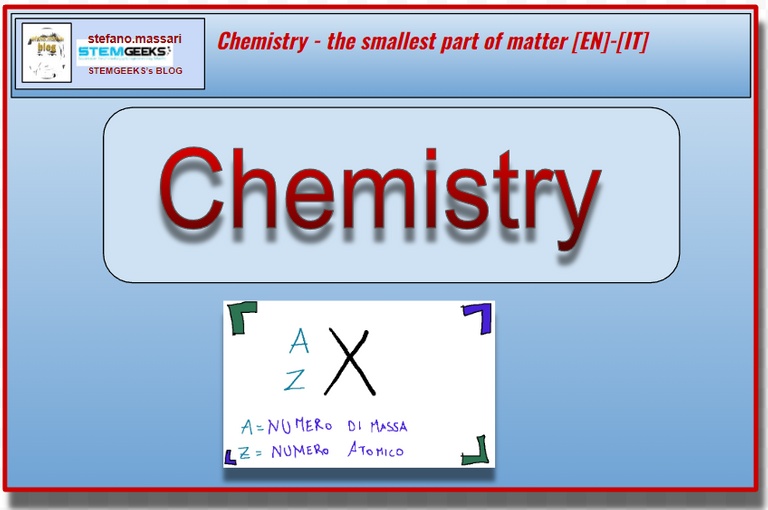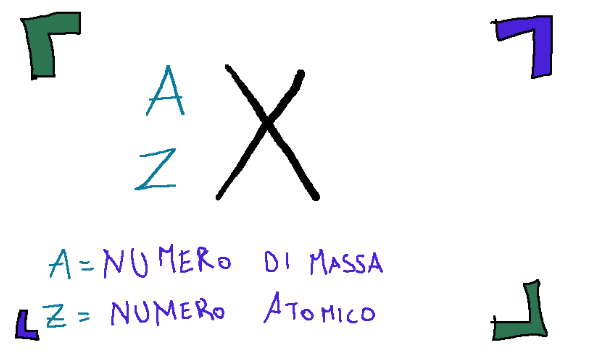Chemistry - the smallest part of matter [EN]-[IT]

~~~ La versione in italiano inizia subito dopo la versione in inglese ~~~
ENGLISH

The smallest part of matter
The atom is the smallest part of matter.
The fundamental subatomic particles are protons, electrons and neutrons.
The atomic number
The atomic number is the number of protons contained in the nucleus of the atom and is usually denoted by a Z
The mass number
The mass number is the sum of protons plus neutrons and is usually denoted by the letter A
Isotope
An isotope is an atom that has the same atomic number (Z) but a different mass number (A) and therefore a different atomic mass.
Nuclide
The nuclide is a single nuclear species, characterized by a specific atomic number and a specific mass.
Different types of atoms
There can be 92 different types of atoms in nature. They are distinguished from each other by the value of the atomic number.
Substances
A substance is a collection of atoms.
Substances can be made up of atoms of the same kind and these substances are called elements.
Then there are substances made up of atoms of different species, these are called compounds or molecules.
Compounds or molecules are indicated with formulas that specify which and how many atoms are present in the compound.
The number placed in front of the symbols and formulas is called coefficient and indicates the number of atoms or molecules considered.
Ion
When an atom with no electric charge because the number of protons is equal to that of electrons loses or gains one or more electrons, it becomes a particle with an electric charge, and this particle is called an ion.
Conclusions
The atomic number corresponds to the number of protons contained in an atomic nucleus. In a neutral, i.e. uncharged, atom, the atomic number is also equal to the number of electrons. If this were not the case, ie if the number of electrons were greater or less than the number of protons, we would be in the presence of an ion.

ITALIAN

La più piccola parte della materia
L’atomo è la più piccola parte della materia.
Le particelle subatomiche fondamentali sono i protoni, gli elettroni e i neutroni.
Il numero atomico
Il numero atomico è il numero di protoni contenuti nel nucleo dell'atomo e di solito viene indicato con una Z
Il numero di massa
Il numero di massa è la somma dei protoni più i neutroni e di solito questo numero viene indicato con la lettera A
Isotopo
L’isotopo è un atomo che mantiene lo stesso numero atomico (Z) ma differente numero di massa (A) e perciò differente massa atomica.
Nuclide
Il nuclide è una singola specie nucleare, caratterizzato da un determinato numero atomico e da una determinata massa.
Tipi diversi di atomi
In natura possono esistere 92 tipi diversi di atomi. Essi si distinguono l’uno dell’altro per il valore del numero atomico.
Sostanze
Una sostanza è un insieme di atomi.
Le sostanze possono essere costituite da atomi della stessa specie e queste sostanze vengono chiamate elementi.
Ci sono poi sostanze costituite da atomi di specie diverse, queste sono dette composti o molecole.
I composti o le molecole vengono indicate con le formule che precisano quali e quanti atomi sono presenti nel composto.
Il numero posto davanti ai simboli e alle formule viene detto coefficiente ed indica il numero di atomi o di molecole considerate.
Ione
Quando un atomo privo di carica elettrica in quanto il numero di protoni è uguale a quello degli elettroni perde o acquista uno o più elettroni, diventa una particella dotata di carica elettrica, e questa particella viene chiamata ione.
Conclusioni
Il numero atomico corrisponde al numero di protoni contenuti in un nucleo atomico. In un atomo neutro, cioè privo di carica, il numero atomico è pari anche al numero di elettroni. Se così non fosse, cioè se il numero di elettroni fosse maggiore o minore del numero dei protoni, saremmo in presenza di uno ione.
THE END
previous posts
https://stemgeeks.net/hive-163521/@stefano.massari/chemistry-introduction-en-it
La tabella periodica!
!discovery 25
Ecco… bisogna fare un ripasso anche della tabella periodica. Mi hai dato un’idea per i prossimi post
This post was shared and voted inside the discord by the curators team of discovery-it
Join our Community and follow our Curation Trail
Discovery-it is also a Witness, vote for us here
Delegate to us for passive income. Check our 80% fee-back Program
Spettacolo, grazie per questo ripasso, fa sempre molto piacere rispolverare i vecchi studi.
Esatto questi bravi post sono da considerarsi un ripasso. Grazie per essere passato di qua
Hello friend, a pleasure to read a post of yours, this time I see that you are a specialist in chemistry, very educational your post and to know what is related to the atom and its chemical characteristics, greetings and I hope to continue reading you more of this content related to chemistry.
Thanks for this wonderful comment. I will continue to make these posts. Reading your comment made me very happy. My knowledge is very little compared to yours !LOL
lolztoken.com
Sofishticated.
Credit: reddit
@carlos84, I sent you an $LOLZ on behalf of @stefano.massari
(3/6)
ENTER @WIN.HIVE'S DAILY DRAW AND WIN HIVE!
Un post molto interessante
Mi piacerebbe avere più tempo da dedicare al blogging e fare più post a riguardo della chimica, della fisica e della matematica